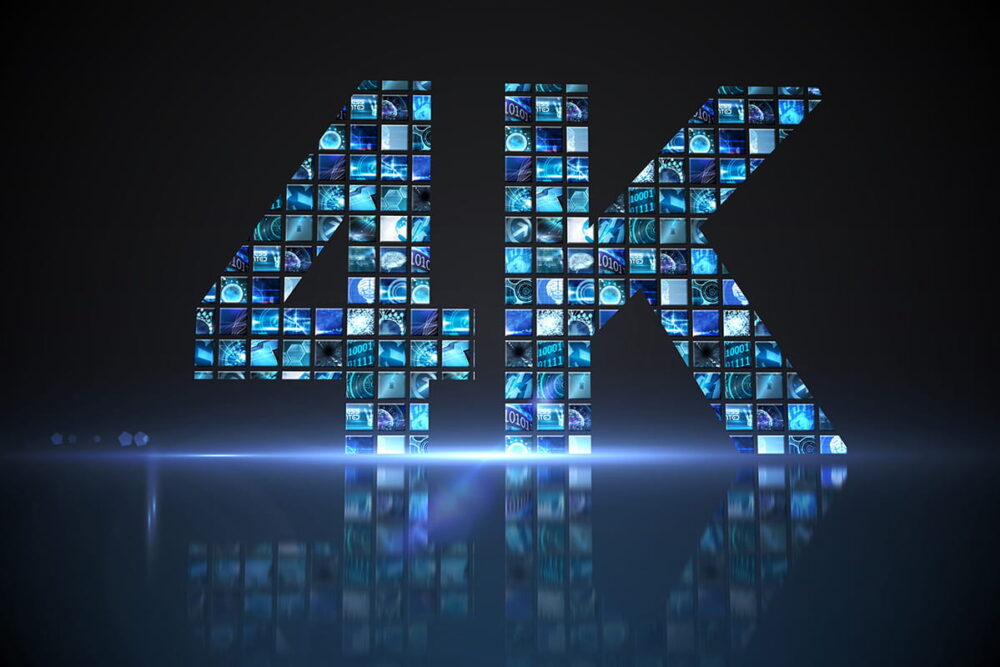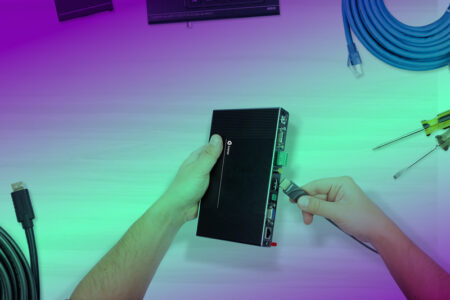Now, here’s where things get tricky. An Ultra HD display signal has four times as many pixels in a single frame as a Full HD video signal; 9.9 million versus 2.48 million. That’s quite a boost in payload, and it creates a speed limit challenge when interfacing, particularly as we increase the frame rate and color bit depth.
There is truth in numbers! A Full HD video frame has a total of 2200×1125 pixels, including blanking. Multiply that by a frame rate of 60Hz, using 10-bit RGB color (or 4:4:4, using a broadcast notation), add in the customary 20% ANSI bit overhead, and you have a payload of 5.346 gigabits per second. (Let’s call it 5.4 Gb/s, to simplify matters).
How did we arrive at that number? Well, 2200 pixels × 1125 pixels × 60 = 148.5 MHz, which is a common pixel clock frequency for Full HD. Next, we multiply 148.5 by 3, because we’re using RGB color. And we then multiply that product by 12 (10-bit color + 2 bits as overhead) to arrive at our final number: 5.4 Gb/s of data. That can easily fit through an HDMI 1.4 connection, which has a maximum rate of 10.2 Gb/s.
Okay, time to exit our Honda Civic and get into a high-performance BMW M3. Our Ultra HD signal has a total of 4400 horizontal and 2250 vertical pixels with blanking. Refreshing that signal 60 times per second gives us a pixel clock of 594 MHz, and using 10-bit RGB color, we now have a sustained data rate of 21.384 Gb/s. Wow! (Not surprisingly, that’s four times as fast as our Full HD signal calculation.)
That’s way too fast for HDMI 1.4. In fact, it’s even too fast for HDMI version 2.0, which can’t transport data any faster than 18 Gb/s. (That’s why a newer and faster version of HDMI – v2.1 – is just now coming to market.) Hmmm…do we really need 10-bit RGB color for everyday applications? Probably not, so let’s dial the bit depth back to 8 bits per color, which should suffice for high-resolution graphics and images.
Jiggering the math that way drops our bit rate down to 17.82 Gb/s, which gets us within the speed limit of HDMI 2.0. We can also crawl under the limbo bar by reducing color resolution to 4:2:2 or 4:2:0. A 10-bit Ultra HD signal with 4:2:2 color has a data rate of 14.26 Gb/s, while a 10-bit 4:2:0 version drops that number to 10.7 Gb/s.
And we can trim the data rate even further by cutting the frame rate in half to 30 Hz. Initially, that’s what many signal management companies did to accommodate Ultra HD signals while retaining the HDMI 1.4 interface. But as our display screens get larger (and they are getting a LOT larger), lower frame rates with wider fields of view can produce noticeable flicker. This phenomenon was first observed by Japanese broadcaster NHK as they began rolling out 8K TV broadcasts…but that’s a story for another time.
So, we want to stick with at least a 60 Hz frame rate for our 85-inch Ultra HD LCD monitor or our 120-inch Ultra HD LED wall. We’ll definitely need signal management products equipped with HDMI 2.0, at the minimum. By doing so, we can accommodate more powerful graphics workstations and laptops, where we can set the bit depth to fit our system bandwidth. We can also stream Ultra HD video from physical media and streaming platforms, where the most common color resolution is 4:2:0. Again, an easy fit for our system.
“Hold on there,” you’re probably thinking. “Where is all this demand for Ultra HD coming from?” Time to wake up and smell the coffee, folks: Monitoring and surveillance systems, such as those used by traffic agencies and process control systems always need more pixels on the screen. Gamers are always looking for more pixels on the screen at faster refresh rates with low latency. So do companies engaged in energy exploration, visualization and virtual reality, 3D modeling, and medical imaging. You know the old saying: You can NEVER have enough pixels.
And as we just read, the AV industry is rapidly switching over to Ultra HD displays as Asian display panel “fabs” phase out zero-profit Full HD panels and ramp up Ultra HD panel production. That means single-monitor and TV sizes as large as 98 inches using LCD and OLED technology, and tiled LCD/OLED display walls – plus LED walls – that have 4K, 8K, and even higher pixel counts. If you are looking to build a new signal distribution system, it is a wise bet against the future to support the higher bandwidths required for Ultra HD, all the way through every connection.










